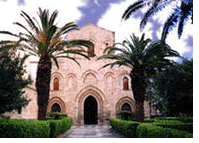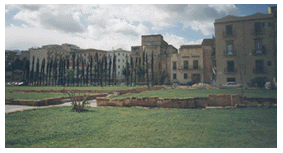...Best of Sicily
presents... Best of Sicily Magazine. ... Dedicated to Sicilian art, culture, history, people, places and all things Sicilian. |
by Carlo Trabia | ||
Magazine Best of Sicily Arts & Culture Fashion Food & Wine History & Culture About Us Travel Faqs Contact Map of Sicily |
The story of the Piazza Magione "restoration" begins in Spring 1943, when the Allies, in preparation for the eventual invasion of Sicily, began the "carpet bombing" of Axis defensive positions protecting the Port of Palermo. Precision bombing, as we know it today, did not yet exist, and areas as far as a kilometer from the coast suffered damage. Civilian casualties were high, as homes, shops and churches were damaged. In the end, the intimidated Fascist troops surrendered Palermo to General Patton's American forces without a fight, the Germans having already fled. (Incredible though it may seem, few Italians under the age of about 60 have much knowledge of such facts, which are not taught in most schools; the civilians killed in Palermo in 1943 are among the war's "Forgotten Italians.") Following the war, the Marshall Plan provided funds for rebuilding this
neighborhood and others. Under the auspices of ecclesiastical administration,
the Basilica of the Magione and the Church of Saint Francis Assisi were
restored to their medieval condition (both had been defaced by Baroque additions
over the centuries), an important factor which makes them tourist attractions
today. On the secular (non-ecclesiastical) front, however, the city's corrupt
post-war administrators and the Mafia made short work of most of the monies
provided by the United States or by the central government in Rome, using
the funds to "develop" new parts of Palermo or build vacation
homes. The Magione district was abandoned. Even aristocrats abandoned their
palaces. Those poorer Palermitans who remained in the surrounding neighborhoods
are the "Forgotten Sicilians." By the 1960s, the state of crumbling
The vast ancient and medieval historical district of Palermo is one of Italy's largest, eclipsed only by those of Rome and (perhaps) Naples. Europe's "most historical street," street, Corso Calatafimi, which runs from Palermo Cathedral to Monreale Abbey, boasts a Phoenician-Carthaginian burial ground, Roman ruins, a Norman-Arab palace (the Cuba) and castle (the Norman Palace) and other treasures. Against the backdrop of this unique heritage, most of Palermo's recent historical restorations have been disasters planned by semi-competent architects who happen to be the friends of local politicians; the Zisa and the Steri are lasting examples of the mediocre reconstruction of medieval castles. But Piazza Magione presented a different problem altogether. By the 1990s, the city had purchased the property where the old buildings had once stood. The immediate issue was no longer a question of what could have been, but of what was by then a fact of life. In reality, the Magione district which existed in 1945 had not existed for decades. Viewed in that context, the grassy park didn't seem like such a terrible idea. It has been criticized on the basis that such parks, popular in places like London and New York, are not part of Sicilian tradition. The new park has been called "the right idea in the wrong place." Such observations overlook certain things. At the very least, the park may provide local children a place to play. A few more trees would make it more inviting. The debate will continue. About the Author: Architect Carlo Trabia has written for various magazines and professional journals. | |
Top of Page |
 In the area of Palermo between the thirteenth century Basilica of the
In the area of Palermo between the thirteenth century Basilica of the  decay was
so extensive that it was decided to level the entire Magione area, forming
what became, in effect, a large parking lot.
decay was
so extensive that it was decided to level the entire Magione area, forming
what became, in effect, a large parking lot.